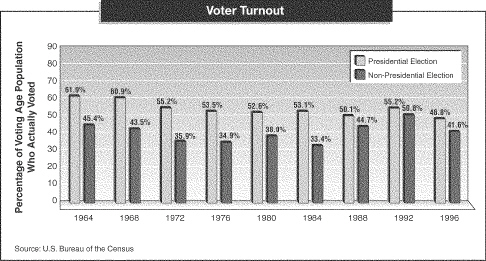Matching
|
|
|
IDENTIFYING KEY TERMS
Match each item with the correct statement
below. You will not use all the terms. a. | electorate | b. | poll
tax | c. | literacy | d. | preclearance | e. | political
efficacy | f. | independent | g. | gerrymandering | h. | split-ticket
voting |
|
|
|
1.
|
____, a person's ability to read or write, is no longer used to qualify
voters.
|
|
|
2.
|
Dividing electoral districts to limit the voting strength of a particular group
is known as ____.
|
|
|
3.
|
____ is the term regularly used to describe those people who have no specific
major party affiliation.
|
|
|
4.
|
People who do not believe their actions can affect politics have no sense of
____.
|
|
|
5.
|
In the United States, the ____, or the potential voting population, is made up
of nearly 200 million people.
|
Other
|
|
|
IDENTIFYING KEY TERMS
Use each key term below in a sentence that
shows the meaning of the term.
|
|
|
6.
|
injunction
|
|
|
7.
|
straight-ticket voting
|
|
|
8.
|
off-year election
|
|
|
9.
|
political socialization
|
|
|
10.
|
registration
|
Multiple Choice
Identify the
choice that best completes the statement or answers the question.
|
|
|
MAIN IDEAS
|
|
|
11.
|
Which of the following is NOT a long-term trend marking the expansion of
suffrage in the United States?
a. | removing restrictive requirements based on religious belief | b. | the Federal
Government taking less of a role in protecting suffrage rights | c. | eliminating
requirements based on race | d. | eliminating requirements based on tax
payments |
|
|
|
12.
|
In the past, some States limited voting rights by
a. | passing political socialization laws. | b. | charging a poll tax. | c. | eliminating the
literacy test. | d. | overruling grandfather clauses. |
|
|
|
13.
|
The provisions of the Voting Rights Act of 1965 and its amendments of 1970,
1975, and 1982 apply to
a. | all national, State, and local elections. | b. | federal elections
only. | c. | State and local elections only. | d. | all federal and State elections, but not to all
local elections. |
|
|
|
14.
|
The phenomenon in which fewer votes are cast for offices farther down the ballot
is called
a. | voter alienation. | b. | straight-ticket voting. | c. | split-ticket
voting. | d. | ballot fatigue. |
|
|
|
15.
|
All of the following are significant reasons for nonvoting in United States
elections today EXCEPT
a. | long-term mental or physical illness or illness on an election
day. | b. | rules and regulations that make registration and voting
cumbersome. | c. | widespread use of religious and literacy tests. | d. | apathy or distrust
of politics. |
|
|
|
16.
|
The term political socialization can be defined as the
a. | process in which individual initiative is abandoned in favor of party
politics. | b. | belief that one's vote does not count. | c. | process by which
people formulate their political attitudes and opinions. | d. | practice of voting
for candidates of only one specific party in any given election. |
|
|
|
17.
|
The expansion of suffrage in the United States
a. | was outlined in the text of the Constitution. | b. | was accomplished
outside the United States legal system. | c. | is the subject of all constitutional amendments
made since 1810. | d. | has been moved forward by amendments and civil rights
acts. |
|
|
|
18.
|
Literacy tests worked to deny the right to vote to African Americans primarily
because
a. | all white voters had higher literacy rates. | b. | the tests were only
required in Southern States. | c. | African Americans were asked questions that
were more difficult than those asked of prospective white voters. | d. | it was specifically
provided for in the Constitution. |
|
|
|
19.
|
Which act first established a federal commission to investigate claims of
individual voter discrimination?
a. | Civil Rights Act of 1957 | b. | Civil Rights Act of 1960 | c. | Civil Rights Act of
1964 | d. | Voting Rights Act of 1965 |
|
|
|
20.
|
People with no sense of political efficacy
a. | are also known as "cannot-voters." | b. | only vote in
off-year elections. | c. | display a strong sense of party
identification. | d. | feel that any choice they make will have no effect. |
|
Short Answer
|
|
|
INTERPRETING GRAPHSUse the graph to answer the following
questions.

|
|
|
21.
|
What percentage of voters turned out for the presidential election in 1964? In
1988?
|
|
|
22.
|
Which year shows the greatest difference between voter turnout for presidential
elections versus non-presidential elections?
|
|
|
23.
|
What percentage of voters turned out for the presidential election and the
non-presidential election in 1976?
|
Essay
|
|
|
CRITICAL THINKING
|
|
|
24.
|
Formulating Questions You are working on a committee to examine whether
16-year-olds in your State should vote. Make up three to five questions that you would ask
16-year-olds to determine if they should gain the right to vote.
|
|
|
25.
|
Recognizing Bias What was Benjamin Franklin suggesting about the
government when he said that a man whose only property was a jackass would lose his right to vote if
the jackass died?
|
|
|
26.
|
Identifying Central Issues Why is the issue of voter rights so important
in the United States?
|